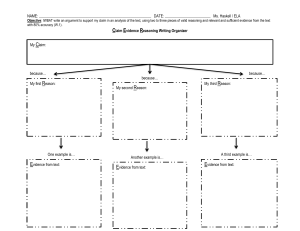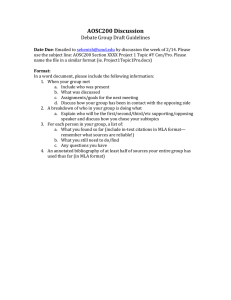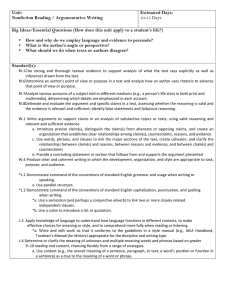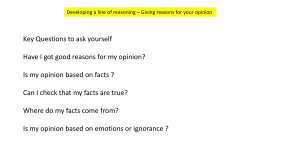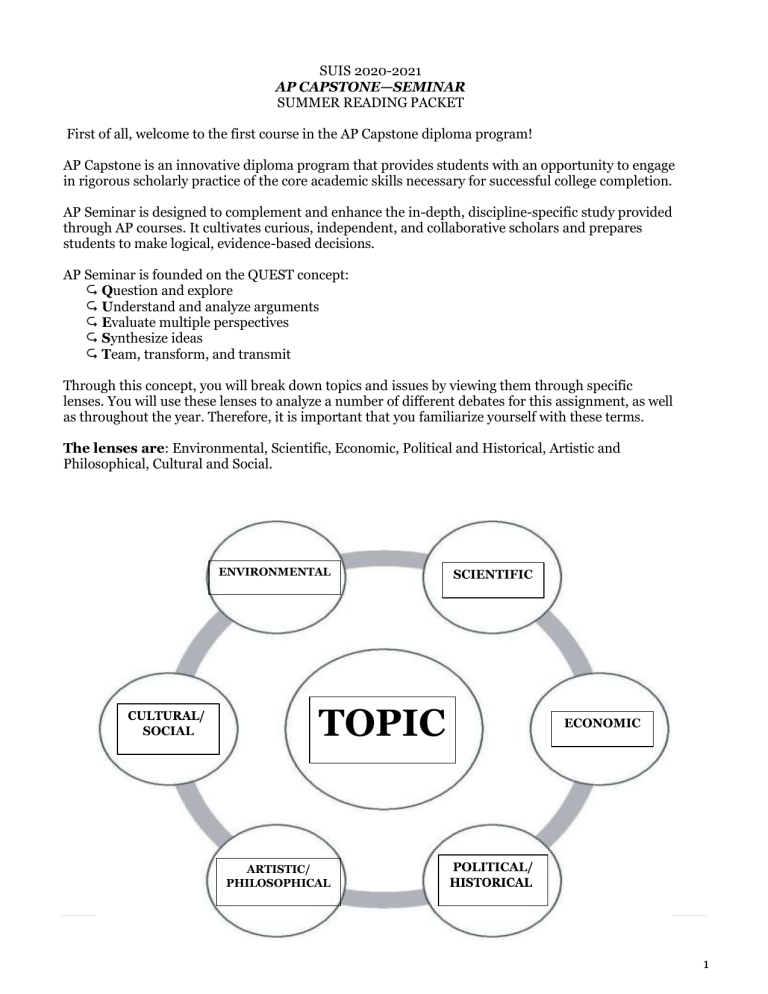
SUIS 2020-2021 AP CAPSTONE—SEMINAR SUMMER READING PACKET First of all, welcome to the first course in the AP Capstone diploma program! AP Capstone is an innovative diploma program that provides students with an opportunity to engage in rigorous scholarly practice of the core academic skills necessary for successful college completion. AP Seminar is designed to complement and enhance the in-depth, discipline-specific study provided through AP courses. It cultivates curious, independent, and collaborative scholars and prepares students to make logical, evidence-based decisions. AP Seminar is founded on the QUEST concept: Question and explore Understand and analyze arguments Evaluate multiple perspectives Synthesize ideas Team, transform, and transmit Through this concept, you will break down topics and issues by viewing them through specific lenses. You will use these lenses to analyze a number of different debates for this assignment, as well as throughout the year. Therefore, it is important that you familiarize yourself with these terms. The lenses are: Environmental, Scientific, Economic, Political and Historical, Artistic and Philosophical, Cultural and Social. ENVIRONMENTAL SOCIAL SCIENTIFIC TOPIC ARTISTIC/ PHILOSOPHICAL ECONOMIC POLITICAL/ ge 1 To prepare for our studies next year in AP Seminar, the following assignment has been created to give you a glimpse of the types of questions we will ask, research we will conduct, and arguments we will write. You will use the lenses above to complete the assignment below. Part I 1. Choose a socially-relevant topic that is in the news. (Entertainment “news” (gossip) is not socially relevant!). Some examples are: college campus rapes, climate change, the upcoming presidential election, alleged racism in police departments and shootings of black men, standardized testing in schools, and the proliferation of violence among extremist groups like ISIS and Al-Shabaab. 2. Find three articles from three different sources. Print and read the articles. 3. For each article, fill in the chart on the following page. 4. Write a reflection in which you address: a. Why you chose your topic and why you believe it is socially relevant. b. How did you find your sources, and how do you know that your sources are credible and trustworthy? c. What you learned about the topic that you didn’t know before. d. How the topic is being covered in the news. What are the areas of focus? e. What final conclusions can you draw about the topic based on your reading? i. Each reflection must be 250 words minimum. ii. Each reflection must follow MLA guidelines. iii. MLA templates will be available for download at Part II 1. Go to the website http://www.nytimes.com/roomfordebate. 2. The left hand side of the website has the week’s featured topics for discussion, labeled “Recent Discussions”. You will need to scroll down to see the different topics. 3. Click on a topic title you are interested in, you will see a list of debaters and their essay titles will appear. Click on “Read the Discussion” to access the first article in the grouping. 4. Click on each essay title to read the other essays in the grouping. 5. You must read ALL articles. Be sure to read the entire article, not just the excerpt. 6. Choose two articles that provide different perspectives on a topic that can be attributed to one of the lenses mentioned above. You will do this twice. E.g. Issue A is a Political/Historical lens and has two articles: one for and one against; Issue B has an Environmental lens and has two articles: one for and one against. 7. Print all four of the articles in the discussions. Read and annotate the four articles and complete the journal assignment outlined below. 8. Create an MLA works cited entry for each article (see the Purdue OWL for tips). 9. In no more than two typed, double-spaced pages, under the citation, provide the following: a. Identify the different issues presented regarding the topic and how it connects to one of the lenses outlined in the diagram above. b. Identify the author’s main idea, argument, or thesis. c. How does the author create his/her argument? What are the lines of reasoning? d. Do you believe the author and the evidence are credible and reliable? Why or why not? e. Evaluate the article’s effectiveness. Is it convincing? Why or why not? f. Utilize at least 2 quotes from the articles for support. i. Utilize the attached glossary for the definitions of these terms. ii. The journal entry should be typed and double spaced. i. See the attached document on how to annotate. ii. Journal entries should be at least 250 words and written in MLA format. 2 Title/Author and 1-Sentence Summary Source/Format Central Claim of Article Intended Audience and Purpose Additional Notes (Is there bias evident? Is this coverage significantly different from the others?) 3 How to Annotate What Not to Do 1. Don’t use a fat-tipped highlighter to highlight large amounts of text. You need to write notes about what you read. If you need color, use some color pens. 2. Don’t mark large volumes of text; you want important points to stand out. You should only be highlighting about 20% of the text. 3. Don’t mark the obvious. Don’t waste time marking things you already know. What to Do 1. Mark the text with pen, pencil, or colored pens. 2. Underline the topic sentence in a passage, then it will be easier to find the supporting evidence and explanations. 3. Use codes. For example, use question marks for places of disagreement, exclamation points for agreement or a strong statement, triangles to indicate a change in thinking, a star for the topic sentence. 4. Write the passage topic in the margin. 5. Write questions in the margins. When you don’t understand something, write the question in the margin, so you can remember to come back to answer it. 6. Circle new and unfamiliar words; look them up as soon as possible. Define them on the article. 7. Add your or other author’s perspectives in the margins. Do they agree or disagree? 8. Add cross-reference notes. 9. Draw arrows to related ideas. 10. Summarize. Add your own summary after the last paragraph. It will help clarify your thinking about the subject. 4 Tips MLA Reference Guide ∞ Purdue has one of the BEST writing programs! Take advantage of the resources online: https://owl.english.purdue.edu/owl/resource/747/01/ It is very important that you understand the lenses presented under the AP Capstone umbrella. ∞ During the second week of school, you will have a quiz on these terms, as well as how to apply them to text. It is very important that you understand the terms contained in the glossary. ∞ During the second week of school, you will have a quiz on these terms, as well as how to apply them to text. Under NO circumstances should you wait until the last minute to complete this assignment! ∞ I will not be available the day before the assignment is due to answer questions regarding this assignment. All questions should be taken care of in advance. The night before is too late. ∞ I will not print out articles or your responses. Do your own work!!!! ∞ There is ZERO TOLERANCE FOR cheating! ∞ Students who have signed up for an AP Course will be evaluated in the classroom to assess the knowledge that they have mastered and later take a national exam that will compare their knowledge in the subject with students across the country. It is extremely important that work in and out of the classroom honestly reflect each student’s accomplishments; therefore, academic integrity is extraordinarily important in this level of instruction. I will monitor and strictly enforce policies dealing with academic dishonesty. ∞ It must be understood by students and parents that the consequences for academic dishonesty in this class are very high. In addition to parent notification, students will be subject to: A “0” on the test, assignment or project that is involved in the infraction. A written referral sent to the discipline office outlining the offense. A copy of the referral will be sent for evaluation to the faculty advisor for National Honor Society and/or the advisor for appropriate magnet programs if applicable. ∞ You’re taking an AP class because you have the intellectual capacity to compete with the best of the best. Don’t lose out on your opportunity to showcase how intelligent are. Prove to yourself and your peers that you belong here. Let’s not cheat our way through life. It will catch up to you. I promise! 5 AP Seminar Glossary Alignment: cohesion between the focus of inquiry, the method of collecting information, the process of analysis of information, and the conclusions made to increase understanding of that focus Argument: a claim or thesis that conveys a perspective developed through line of reasoning and supported by evidence Assumption: a belief regarded as true and often unstated Author: the one who creates a work (e.g. article; research; study; foundational, literary, or philosophical text; speech; broadcast, or personal account; artistic work or performance) that conveys a perspective and can be examined Bias: a personal opinion, belief or value that may influence one’s judgment, perspective, or claim Claim: a statement made about an issue that asserts a perspective Commentary: discussion and analysis of evidence in relation to the claim which may identify patterns, describe trends, and/or explain relationships Complex issue: issue involving many facets or perspectives that must be understood in order to address it Concession: acknowledgment and acceptance of an opposing or different view Conclusion: understanding the resulting from the analysis of evidence Context: the intent, audience, purpose, bias, situatedness, and/or background (larger environment) of a source or reference Conventions: the stylistic features of writing (e.g. grammar, usage, mechanics) Counterargument: an opposing perspective, idea, or theory supported by evidence Credibility: the degree to which a source is believable and trustworthy Cross-curricular: goes beyond the traditional boundary of a single content area or discipline Deductive: a type of reasoning that constructs general propositions that are supported with evidence Evidence: information (e.g. data, quotations, excerpts from text) used as proof to support a claim or thesis Fallacy: evidence or reasoning that is false or in error Implication: a possible future effect or result Inductive: a type of reasoning that presents cases or evidence that lead to a logical conclusion Inquiry: a process for seeking truth, information, or knowledge through a study, research investigation, or artistic endeavor/work Interdisciplinary: involving two or more areas of knowledge 6 Issue: important problem for debate or discussion Lens: a filter through which an issue or topic is considered or examined Limitation: a boundary or point at which an argument or generalization is no longer valid Line of reasoning: arrangement of claims and evidence that lead to a conclusion Literature- the foundational and current texts of a field or discipline of study Perspective- a point of view conveyed through an argument Plagiarism: failure to acknowledge, attribute, and/or cite any ideas or evidence taken from another source Point of view: a position or standpoint on a topic or issue Primary source: an original source of information about a topic (e.g. study, artifact, data set, interview, article) Qualification: a condition or exception Qualitative: having to do with text, narrative, or descriptions Rebuttal: contradicting an opposing perspective by providing alternate, more convincing evidence Refutation: disproving an opposing perspective by providing counterclaims and counterevidence Reliability: the extent to which something can be trusted to be accurate Resolution: the act of solving a problem or dispute Scaffolding: the provision of temporary structured support for students to aid skill development Secondary source: a commentary about one or more primary sources that provides additional insight, opinions, and/or interpretation about the primary source, data, study, or artifacts Sequencing: the organization of curriculum content into an order which progresses from simple to more complex Solution: a means of answering a question or addressing a problem or issue Text: something composed (e.g. articles; research studies; foundational, literary, and philosophical texts; speeches; broadcasts, and personal accounts; artistic works and performances) that conveys a perspective and can be examined Thesis: a claim or position on an issue put forward and supported by evidence Tone: the way in which an author expresses an attitude about his or her topic or subject through rhetorical choices Validity: the extent to which an argument or claim is logical Vocal variety: changing vocal characteristics (e.g. pitch, volume, speed) in order to emphasize ideas, convey emotion or opinion, or achieve other specific purposes 7
